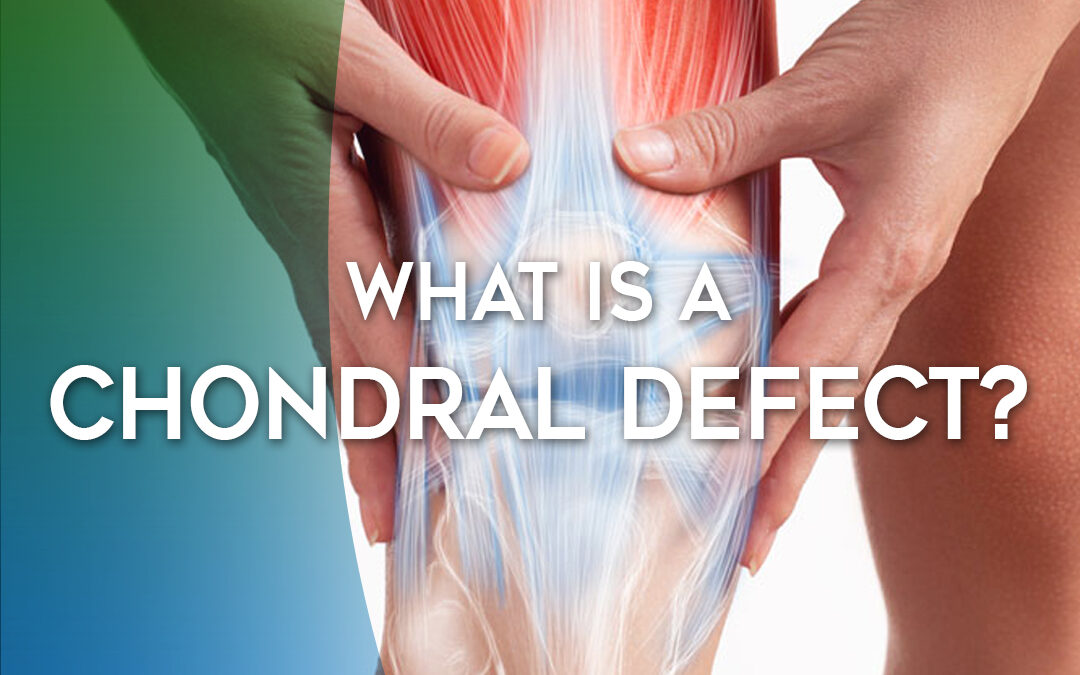A chondral defect is a localized area of articular cartilage damage on a joint surface. In most cases, chondral defects develop in the knee joints, so the knee will be the focus of this blog article. Articular cartilage is the tough, smooth and durable substance that covers joint surfaces and ensures that the bones of the knee glide over each other without friction during movement. Damage to this cartilage leads to a lot of painful friction and inflammation within the knee joint.
Chondral defects are characterized by grade based on severity.
- Grade I: Cartilage becomes soft and indented
- Grade II-III: Cartilage becomes progressively more shredded, ragged, and fragmented
- Grade IV: Cartilage wears away completely, exposing the underlying bone
People of all ages can develop chondral defects. Keep reading to learn more about symptoms and treatment options.
What Causes Chondral Defects?
Chondral defects may be caused by acute trauma to the knee from a direct blow, a sudden pivot or twist, or a fall. In some cases, cartilage injuries accompany other knee injuries like ligament tears. And in other cases, chondral defects develop as articular cartilage naturally wears down over time.
Signs and Symptoms
The primary function of articular cartilage is to enable smooth, frictionless movement between bones of a joint during movement. When articular cartilage is damaged, the bones rub painfully during movements like walking, running and climbing stairs. The following symptoms may develop:
- Joint pain
- Stiffness
- Swelling
- Loss of range of motion
- Instability, buckling, or “giving way” of the knee
- Locking or catching during bending motions
- A grating sound during movement
Complications
If left untreated, chondral defects can lead to degenerative osteoarthritis, chronic joint pain, and loss of movement in the knee joint. If you have any of the symptoms listed above, see your doctor as soon as possible for an evaluation and treatment.
Diagnosis
Your doctor will probably use several of the following tests to accurately diagnose a chondral defect.
- Medical history and physical exam. Your doctor will take down your medical history and ask you about recent injuries or traumatic incidents. He or she will perform a physical exam to assess your pain, swelling, range of motion, and other physical symptoms. A physical exam alone is not enough to diagnose a chondral defect.
- X-ray exam. Your doctor may request an X-ray to rule out conditions like arthritis or bone spurs. While an X-ray won’t reveal a cartilage defect, your doctor may look for decreased space between bone surfaces. Joint space narrowing is an early indicator of cartilage loss.
- MRI scan. An MRI exam will reveal cartilage damage and defects.
- Arthroscopy. Arthroscopy provides your doctor with the best look at cartilage damage inside the knee joint. During an arthroscopic procedure, your doctor will insert a small fiber optic camera in the joint, and use guided images to assess the location, size and severity of a chondral defect.
Treatment Options
Your treatment options will depend on the size and severity of the defect. Initially, your doctor will likely recommend conservative treatments that can help relieve your symptoms: anti-inflammatory medications, cortisone injections, hyaluronic acid injections, physical therapy, and weight loss.
Non-operative treatments can help reduce pain and improve functional mobility, but can’t facilitate cartilage regrowth. Further treatment requires a surgical procedure.
Currently, there are several surgical options available to treat chondral defects, with varying levels of success.
- Microfracture. During a microfracture, your surgeon will create a controlled area of bleeding in the bone. The blood clots and forms scar tissue, called fibrocartilage. Fibrocartilage isn’t as strong or long-lasting as articular cartilage, but it is durable enough to function as cartilage does for many years.
- Osteochondral autograft transfer. During an osteochondral autograft transfer, plugs of healthy cartilage are removed from elsewhere in the knee and transplanted in the defect.
- Autologous chondrocytes implantation. During autologous chondrocytes implantation, articular cartilage cells are removed from your knee and cultured in a lab. Afterward, the cells are implanted to create a new cartilage surface over the defect. This procedure is typically used for large defects.
Some of these procedures are relatively new and don’t have enough research to decisively prove long-term efficacy. After undergoing any of these procedures, you may experience short-term relief but begin having symptoms again down the road. Surgical procedures like cartilage transfers and implantations require more research in the field.
Have You Considered the iO-Core™ Procedure?
There is another option. The iO-Core™ procedure is a minimally invasive surgery that targets the root cause of joint pain. The procedure combines biologics with orthopedic methods to treat joint pain caused by arthritis, bone marrow lesions, chondral defects, and other traumas. It treats both surface cartilage loss and underlying bone damages that contribute to pain, stiffness, and loss of joint mobility.
The iO-Core™ procedure is performed on an outpatient basis by board-certified doctors trained in the iO-Core™ technique. Many patients begin experiencing pain relief within one week. And unlike many other joint treatments, iO-Core™ is designed to prevent further joint damage.
Many people who were told they needed a total joint replacement surgery have found long-term pain relief and greater mobility from iO-Core™ instead. Contact our team today to learn more and see if you qualify.

